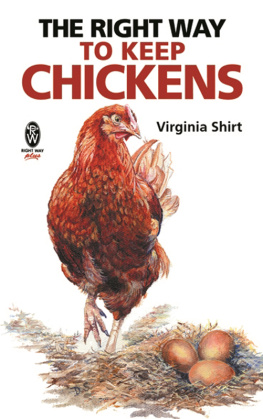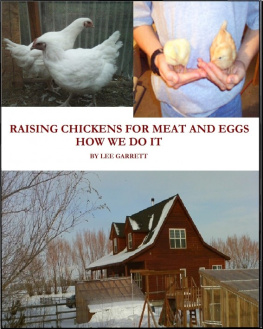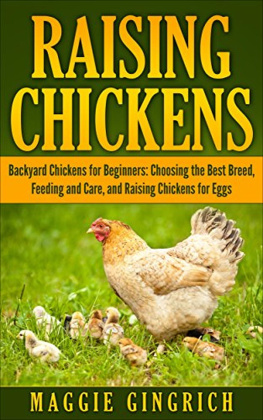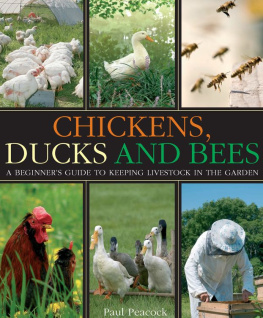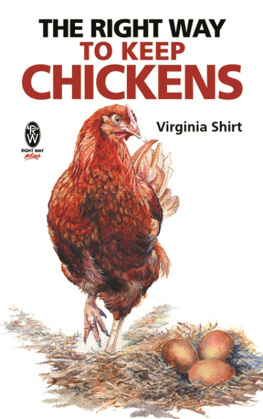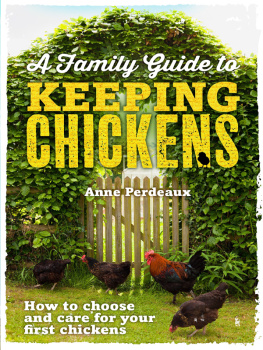The Right Way to Keep Chickens
Where to find Right Way
Elliot Right Way take pride in our editorial quality, accuracy and value-for-money. Booksellers everywhere can rapidly obtain any Right Way book for you. If you have been particularly pleased with any one title, do please mention this to your bookseller as personal recommendation helps us enormously.
Please send to the address on the back of the title page opposite, a stamped, self-addressed envelope if you would like a copy of our free catalogue. Alternatively, you may wish to browse through our extensive range of informative titles arranged by subject on the Internet at www.right-way.co.uk
We welcome views and suggestions from readers as well as from prospective authors; do please write to us or e-mail:
The
Right Way
to Keep
Chickens
by
Virginia Shirt

Constable & Robinson Ltd.
5556 Russell Square
London WC1B 4HP
www.constablerobinson.com
First published in the UK 2007
This edition published by Right Way, an imprint of Constable & Robinson, 2008
Copyright Virginia Shirt, 2007
Cover illustration by
All rights reserved. This book is sold subject to the condition that it shall not, by way of trade or otherwise, be lent, re-sold, hired out or otherwise circulated in any form of binding or cover other than that in which it is published and without a similar condition including this condition being imposed on the subsequent purchaser.
A copy of the British Library Cataloguing in Publication
Data is available from the British Library
ISBN: 978-0-7160-3018-8
eISBN: 978-0-7160-2362-3
Printed and bound in the EU
7 9 10 8
Cover illustration: Diz Summers
Dedication
This book, my first publication, is dedicated to My Beautiful Mum. You always believed in me and encourage me in all that I do. Mum I love you so much and will love you forever and one more day.
Contents
.
.
.
.
.
.
.
Illustrations
Chapter 1:
Preparing for Your Chickens
It is important to be well prepared for the arrival of your chickens. Once you have decided to make the commitment, you need to have everything ready. You may be lucky enough to know where to purchase your feeding and watering utensils; if not, most feed merchants will happily advise. You will find that most farming suppliers dabble in a few poultry sundries. Pet shops and equestrian outlets may also supply the feed and sundries.
Housing
Depending on the number of chickens you are planning on keeping, you will need to have a suitable-sized house or coop for them. There are many ready-made chicken houses on the market today. Some of them are really lovely but they are also very expensive for what they are. If you are handy with wood and a saw, then it is possible to make your own, and (overleaf) shows one possible design.
I have used empty buildings and converted them into chicken housing. The conversions have been simple: nest boxes, perches, and a light and there you have it. Chickens do not require anything posh or fancy, making it easy to do on a budget.
If you do have a spare shed or similar, the process is easy. You can adapt almost any outbuilding or shed. Some farmers have even roughly converted the back of an old van or even a caravan. These are suitable if your chickens are free-range as they will be out in the day anyway. They would merely be entering the accommodation in order to roost securely and lay eggs. Obviously with a caravan or similar you must not be tempted to overcrowd. This method will cater only for a small flock of eight/ten chickens.
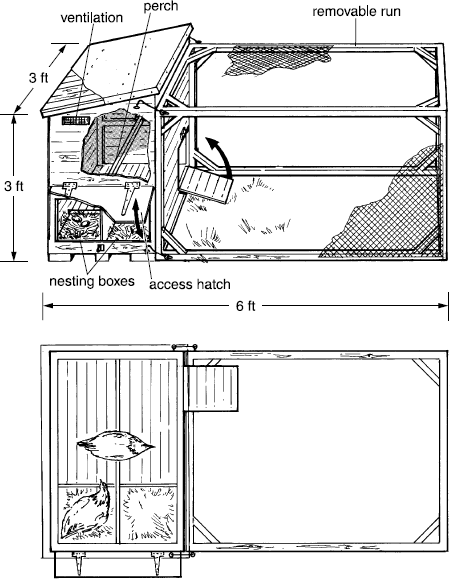
Fig. 1. Make your own chicken coop
This can be made any size; the one shown here, about 6 ft by 3 ft (2m by 1m), will suit about 8 chickens.
Drinkers
Drinkers and feeders come in various sizes with drinkers holding one to four gallons. Again this is dependent on how many birds you would keep. The water needs to be fresh every day; it is no good having a four-gallon drinker for half a dozen birds. It is better to have a smaller drinker that is refreshed daily.
You can serve water to the chickens in an ordinary bowl or trough but the water will become soiled and contaminated. The chickens tend to do droppings in the water if it is not covered. Bell drinkers designed for poultry enable the birds to drink the water without fouling in it. The water containers can be obtained in plastic or galvanized steel. The plastic ones are adequate and cost a lot less than the galvanized ones. It depends on your budget; galvanized will outlive the plastic and therefore you may find it worth the investment. I have used the bell drinkers with success but I do find them rather hard to fill. These plastic bell drinkers need to be filled upside down (this is difficult in itself as you have somehow to balance the drinker and fill with a bucket at the same time). Once full, making it heavy, you then need to put the top on and tip it up the right way without dropping the whole lot! There is a bit of a knack to this particular job.
Automatic bell drinkers are ideal for large numbers of chickens. These save a lot of labour for the keeper. One automatic bell drinker will serve up to one hundred birds. The bell drinker is designed in such a way that the birds cannot sit on it and it is suspended from the roof by a chain. The water pipe comes down parallel to the chain and inserts into the bell which contains a ball valve. This method will provide a constant fresh flow of water.
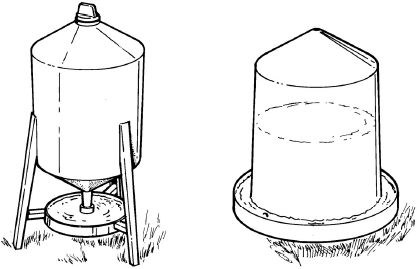
Fig. 2. Types of drinker
A tripod drinker on the left, and a bell drinker, of the non-automatic variety, on the right.
A tripod drinker proves popular with poultry. This is a barrel-shaped water container standing in a tripod. It holds a large amount of water; the water feeds into a small bowl. When the bowl is full, the water stops flowing due to the vacuum; as the water is drunk, more is let through into the bowl. I find the barrel easier to fill than the bell drinker. It fills even easier if you use a funnel. This is my favourite drinker as it is easy to manage.
A nipple drinker is also labour-saving for the keeper. This is a very simple piece of apparatus. Fitted to a plastic water pipe, the pipe is drilled and the threaded nipple screwed in. When the bird presses the nipple, water is released. When the bird has drunk sufficiently, the water pressure shuts the nipple off. These drinkers can tend to have a leakage problem from time to time. In light of this problem make sure you site them away from food and roosting areas.
Feeders
Feeders are also designed so that the chickens can eat the food without contaminating it. Tube feeders are available and provide for all the needs of a chicken feeder. These keep a small amount of food in the base. As the chickens feed, the tube allows more food to drop into the base. Tube feeders reduce waste and contamination greatly.
A feeder needs to be placed at such a height that vermin cannot get at it but the chickens can! It also needs to be at such a height that the chickens do not scatter and waste the food. Place it at chicken neck height so the birds can eat comfortably. Feeders can usually be hung from the ceiling of your house or coop. If you cannot hang them up, they can be placed on concrete slabs or similar. Do not fill the feeders up to the top unless they have a lid on; fill them to about half way. If you fill open ones to the top, the chickens may jump on and feed from this point. This would lead to waste and contamination.
Next page
